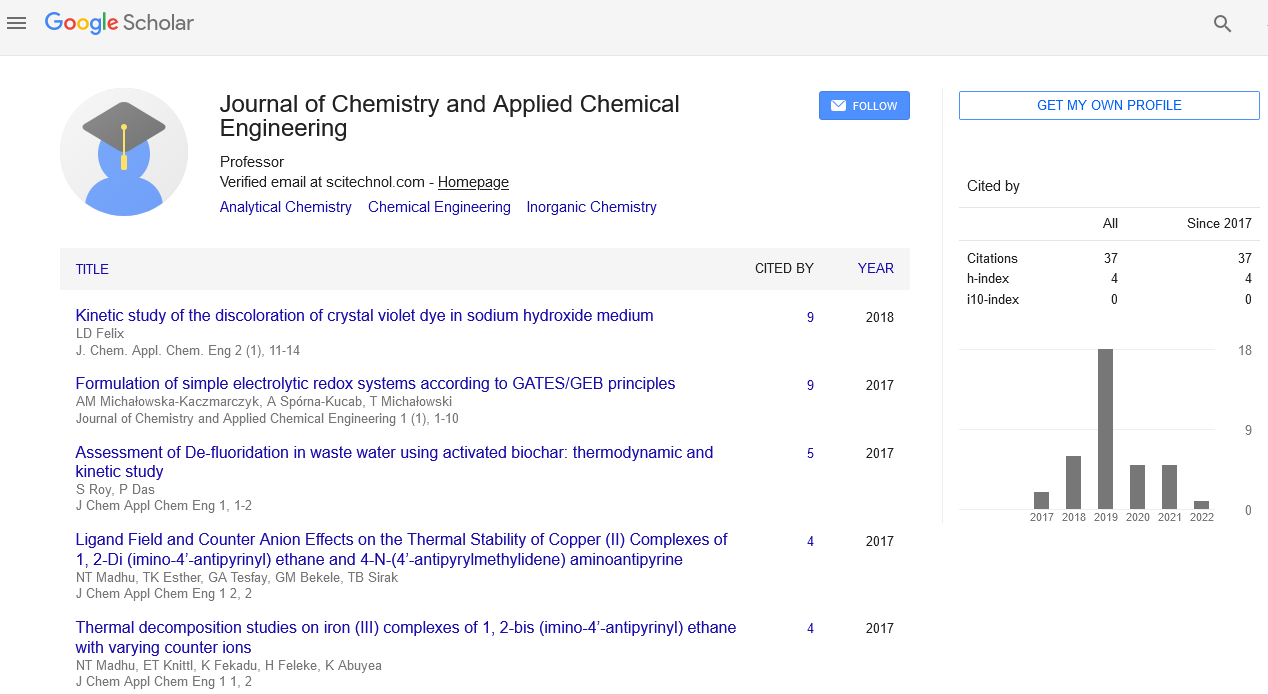Detection of plasma biomarkers with anti-biofouling polymer coated magnetic iron oxide nanoparticles: Simple and efficient method for early diagnosis of Alzheimers disease
Esther Lim, Yuancheng Li, Travis Fields, Andrew Bernal, Hui Wu, Harold Komiskey, Yan Wu, Handong Ma and Hui Mao
GA campus-Philadelphia College of Osteopathic Medicine, USA
Emory University School of Medicine, USA
: J Chem Appl Chem Eng
Abstract
Alzheimer’s disease (AD) imposes a huge economic burden with its diagnostic and therapeutic challenges. The currently available diagnostic tools are expensive, invasive, and insufficient for early screening, and development of non-invasive, low cost detection system for early diagnosis is critical for formulating therapeutic strategies. Nanodiagnostic approach to the development of early screening tool is increasingly recognized as promising strategy and has attracted the attention of researcher and clinicians in recent years. Although extensive effort has been made on the detection of AD biomarkers in cerebrospinal fluid (CSF) at minute concentration level using nanotechnology, there has been no success in clinical translation due to lack of specificity. One of the main reasons is not accounting for the non-specific interactions on the interface of biological sample and detecting-device/probe. Using anti-biofouling polymer coated Magnetic Iron Oxide nanoparticle, we have tested its ability to detect tau-protein in plasma-mimicking environment with high sensitivity and specificity. The anti-biofouling polymer coated Iron Oxide Nanoparticles and their targeting antibody conjugates were prepared as described in the literature. The Fluorescein Isothiocyanate (FITC) labeled tau protein and Tetramethylrhodamine- 5-(and6)-isothiocyanate (TRITC) labeled bovine serum albumin (BSA) was dissolved in PBS with Fetal Bovine Serum (FBS) at 50mg/mL to mimic serum environment. They were then incubated with antibody (Ab)-conjugated IONPs (at final iron concentration of 0.2 mg/mL) or antibodyconjugated Dynabeads for 3 hours before magnetic separation of particles. The separation efficiency (SE) was calculated as the weight ratio of the captured peptide to the spiked. The SE of anti-biofouling IONP for tau protein in PBS with FBS at 0.2, 0.4, 1, 2, 4, 10, and 20 microgram/ mL were found to be in the range of 83.6-91% and 4.5- 6.3% for BSA using fluorescence signal. The false positive rate is calculated at 4.7-6.5%. Under the same condition (PBS-FBS), 26.1 to 47.7% of spiked tau and 27.0 to 37.4% of spiked BSA were isolated using Dynabeads, giving false positive rate from 44.0-51.1%. The antibody conjugated IONP consistently exhibited high separation efficiency for tau protein in PBScontaining FBS with good reproducibility. When BSA was introduced as interference, the SE of IONP declined to below 7% at all concentration, demonstrating IONP’s ability to selectively detect AD biomarker compared to commercial dynabeads. We have developed a sensitive and specific IONP based method with potential application for early AD diagnosis in human serum. With additional benefit of low cost, this simple and efficient method has potential to serve as a non-invasive tool for populationwide screening for AD.
Biography
Esther Lim holds the degree of MD and MBA. He is currently serving an Associate Professor of radiology at PCOM and works in collaboration with Dr Hui Mao, PhD, Professor of Radiology and Biomedical Engineering and the Director for the Molecular Imaging, Biomarkers, and Probe Development at Emory University.
E-mail: estherli@pcom.edu
 Spanish
Spanish  Chinese
Chinese  Russian
Russian  German
German  French
French  Japanese
Japanese  Portuguese
Portuguese  Hindi
Hindi 